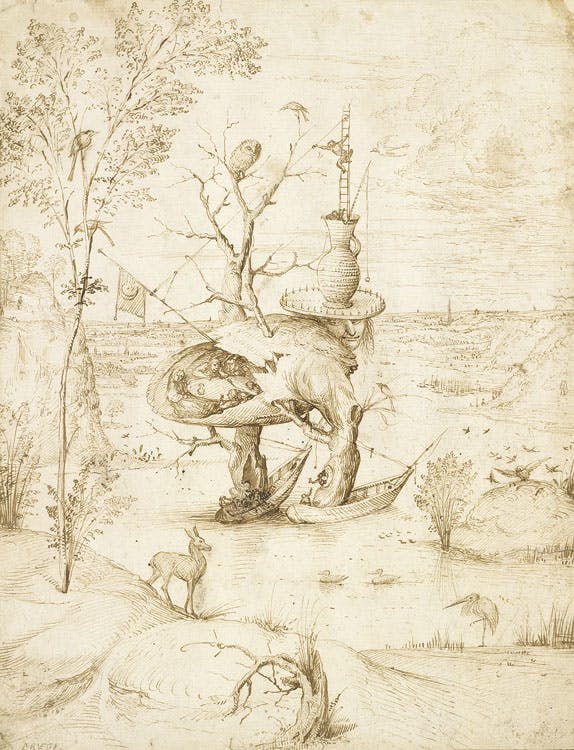
Tales of the City
- Magazine Article
- Exhibitions
Netherlandish drawing practices from Bosch to Bruegel

The Tree Man c. 15001510. Hieronymus Bosch (Netherlandish, 1440–1516). Pen and light- and darkbrown inks on paper; 27.7 x 21.1 cm. Albertina, Vienna, inv. 7876. © The Albertina Museum, Vienna
How does one best live a moral life, be a good citizen, reconcile wealth with piety? These were pertinent questions for city burghers (citizens)—and civic artists—in the Netherlands during the 1500s, when proliferating international trade brought tremendous wealth to its cities. Moralizing images—those that scrutinize human actions and behaviors—emerged as one way to consider these questions and their many variants. Pieter Bruegel the Elder made the drawing Desidia (Sloth) (1557) in Antwerp for a series depicting the seven deadly sins (page 10). He incorporated a dozing female personification, Sloth, and her sluggish donkey into a vast landscape, illustrating the vice through a variety of comic elements and visual proverbs. An enormous man stuck in a house appears so lazy he cannot relieve himself without assistance. Scenes of everyday life, such as the tavern and gamblers, ensure that viewers cannot easily dissociate themselves from the implication that being human means taking the moral high ground is not always possible.

The variety of imaginative, hybrid creatures throughout Bruegel’s drawing recalls the art of Hieronymus Bosch. Working in ’s-Hertogenbosch about 60 years before Bruegel, Bosch pictured devilish creatures within hell scenes as emblems of sin. His drawing The Tree Man (c. 1500–1510) presents a horrifying monster: a giant tree with a human face and a cavernous thorax full of revelers. The beast overtakes a landscape, beyond which we see the profile of a Netherlandish city.
The city as a subject for art, as its intended setting, and as its target audience can be seen throughout the exhibition Tales of the City: Drawing in the Netherlands from Bosch to Bruegel. More than 90 drawings from the superb collection of the Albertina Museum, Vienna, along with examples from the CMA, explore the range of drawing practices in the period that encompassed the Protestant Reformation and the ensuing wars of religion. Urban populations in the Netherlands increased by 30 percent in the early 1500s. City burghers and institutions in Antwerp, Brussels, Haarlem, and other Netherlandish cities sought artists to decorate their churches, guild halls, civic buildings, and private homes. Drawing became an indispensable artistic tool to create and plan projects including stained glass windows, tapestries, ephemeral decorations for festivals, paintings, and prints.
Splendid new buildings, churches, and plazas constituted a city only insofar as people circulated within them. Artists began to visualize this concept by utilizing urban settings as backdrops for narrative scenes, adding layers of meaning for their audience. The drawing by the Master of the Liechtenstein Cabinet on a vibrant, teal-tinted paper portrays nine scenes from the biblical Book of Esther across an imaginative civic stage. The eclectic mix of architecture includes a bizarre square building with a triangular inverted roof. At center stage, King Ahasuerus receives Esther, favoring her with his golden scepter. Esther’s fearless advocacy on behalf of her people was often evoked as exemplary by both sides in religious and political debates. The civic architecture connects past with present, creating resonances between Esther’s story and the world of the viewer.

Artists also sought to impress via displays of virtuoso draftsmanship on subjects that embodied civic prosperity and pride. Such mastery is apparent in the penwerk (pen work) drawing by Jacob Matham, Neptune (1602). Penwerk was a technical innovation requiring keen control of a pen to create swelled ink lines that terminate in tapered points to imitate an engraving. The Roman god of the sea had long-standing associations with the seafaring merchant cities of the Netherlands, appearing as a character in paintings, on architecture, and during civic processions. This fantastical portrait shows the wizened god with a long beard, an enormous conch shell helmet, and various sea-plant and crustacean adornments. The accuracy of Matham’s shell renderings indicates that he studied them in person, probably in the renowned collection of a textile merchant in his home city of Haarlem.

Portraits of urban inhabitants, imaginary and realistic city views, rare cartoons (full-scale drawings) for stained glass windows, and numerous innovative print designs populate this once-in-a-lifetime exhibition, which travels only to Cleveland and Vienna. The plethora of subjects, functions, and techniques of drawings on view demonstrate, above all, how artists grappled with issues of morality, religion, and political debate in their vibrant but turbulent urban environments.